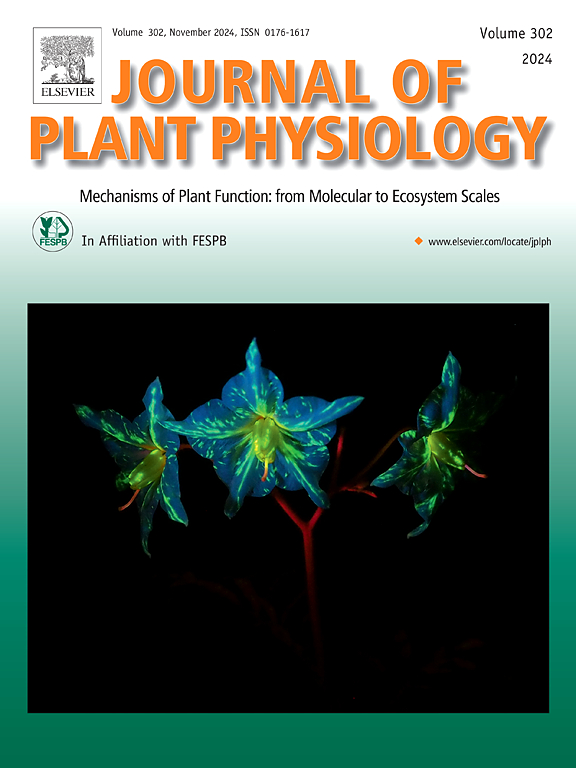Salicylic acid and methyl jasmonate activate key genes of plant-defense pathways conferring partial protection to Polystigma amygdalinum in a susceptible almond cultivar
IF 4.1
3区 生物学
Q1 PLANT SCIENCES
引用次数: 0
Abstract
Red leaf blotch (RLB) of almond, caused by Polystigma amygdalinum, is an economically important foliar disease affecting almond crops. This study explored the hormonal responses of two almond cultivars, namely ‘Tarraco’ (highly susceptible) and ‘Mardía’ (highly tolerant), to P. amygdalinum. Hormonal profiling and gene expression analyses were conducted to examine the roles of salicylic acid (SA), jasmonic acid (JA), and 1-aminocyclopropane-1-carboxylic (ACC) acids, and methyl jasmonate (MeJA) in plant defense mechanisms. Results showed a significant accumulation of SA in symptomatic leaves of both cultivars, suggesting a SA-mediated defense response to the pathogen. However, no substantial changes in JA and ACC levels were observed. In ‘Tarraco’, expression of SA-responsive genes (PR1 and PR5) and ET/JA-associated genes (ACO and ERF1) increased, but the cultivar remained susceptible. In contrast, symptomatic ‘Mardía’ leaves exhibited increased expression in CAD, linked to lignin biosynthesis, while other hormone-related genes (ACO, ERF1, PR1, and PR5) did not show significant changes. Thus, ‘Mardía’ could be following a different defense strategy against RLB. Exogenous applications of SA and MeJA significantly reduced RLB incidence and severity in young ‘Tarraco’ trees, with MeJA enhancing ERF1 expression and SA increasing both ERF1 and CAD expression. MeJA also inhibited plant growth. These findings reveal contrasting defense mechanisms between the two almond cultivars, suggesting a possible protection against RLB through lignin biosynthesis. Furthermore, the protective role of SA would be associated with CAD, indicating a connection between SA signaling and the phenylpropanoid pathway.
水杨酸和茉莉酸甲酯激活植物防御通路的关键基因,使多柱头杏仁具有部分保护作用
杏仁红叶斑病(RLB)是由杏仁多柱头菌(Polystigma amygdalinum)引起的一种重要的经济叶面病害。本研究探讨了两种杏仁品种的激素反应,即‘ Tarraco ’(高度敏感)和‘ Mardía ’(高度耐受),对P. amygdalinum。通过对水杨酸(SA)、茉莉酸(JA)、1-氨基环丙烷-1-羧酸(ACC)和茉莉酸甲酯(MeJA)在植物防御机制中的作用进行激素谱分析和基因表达分析。结果表明,两个品种有症状的叶片都积累了大量SA,表明SA介导了对病原菌的防御反应。然而,JA和ACC水平未见明显变化。在‘Tarraco’中,sa响应基因(PR1和PR5)和ET/ ja相关基因(ACO和ERF1)的表达量增加,但品种仍保持敏感。相比之下,有症状的“Mardía”叶片显示出与木质素生物合成相关的CAD表达增加,而其他激素相关基因(ACO, ERF1, PR1和PR5)没有显着变化。因此,‘ Mardía ’可以遵循一个不同的防御策略,以对抗RLB。外源应用SA和MeJA可显著降低Tarraco幼树RLB的发生率和严重程度,MeJA可增强ERF1表达,SA可增加ERF1和CAD表达。MeJA对植物生长也有抑制作用。这些发现揭示了两种杏仁品种之间的防御机制对比,表明木质素生物合成可能对RLB有保护作用。此外,SA的保护作用可能与CAD有关,表明SA信号传导与苯丙素途径之间存在联系。
本文章由计算机程序翻译,如有差异,请以英文原文为准。
求助全文
约1分钟内获得全文
求助全文
来源期刊

Journal of plant physiology
生物-植物科学
CiteScore
7.20
自引率
4.70%
发文量
196
审稿时长
32 days
期刊介绍:
The Journal of Plant Physiology is a broad-spectrum journal that welcomes high-quality submissions in all major areas of plant physiology, including plant biochemistry, functional biotechnology, computational and synthetic plant biology, growth and development, photosynthesis and respiration, transport and translocation, plant-microbe interactions, biotic and abiotic stress. Studies are welcome at all levels of integration ranging from molecules and cells to organisms and their environments and are expected to use state-of-the-art methodologies. Pure gene expression studies are not within the focus of our journal. To be considered for publication, papers must significantly contribute to the mechanistic understanding of physiological processes, and not be merely descriptive, or confirmatory of previous results. We encourage the submission of papers that explore the physiology of non-model as well as accepted model species and those that bridge basic and applied research. For instance, studies on agricultural plants that show new physiological mechanisms to improve agricultural efficiency are welcome. Studies performed under uncontrolled situations (e.g. field conditions) not providing mechanistic insight will not be considered for publication.
The Journal of Plant Physiology publishes several types of articles: Original Research Articles, Reviews, Perspectives Articles, and Short Communications. Reviews and Perspectives will be solicited by the Editors; unsolicited reviews are also welcome but only from authors with a strong track record in the field of the review. Original research papers comprise the majority of published contributions.
 求助内容:
求助内容: 应助结果提醒方式:
应助结果提醒方式:


